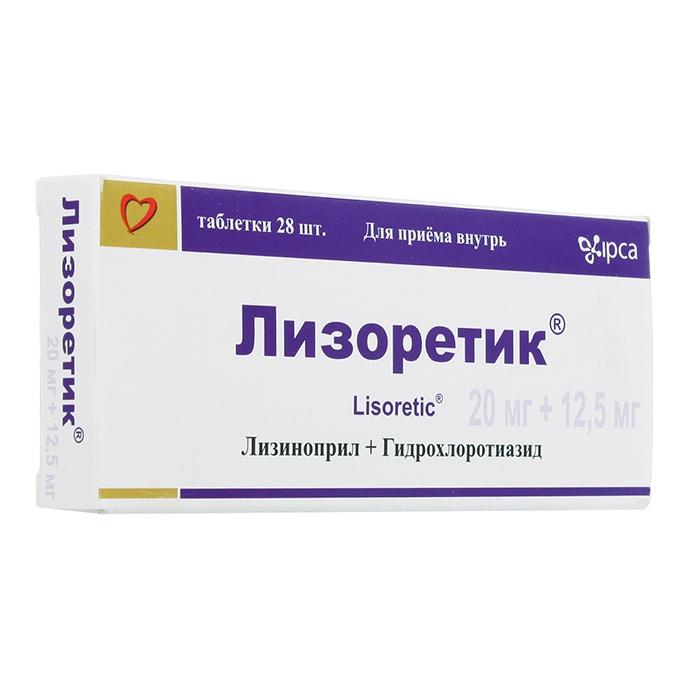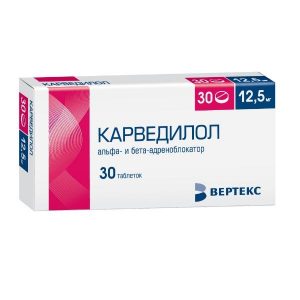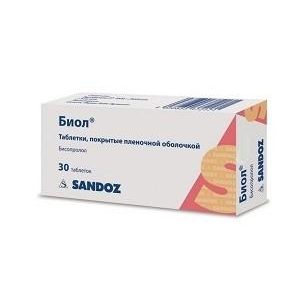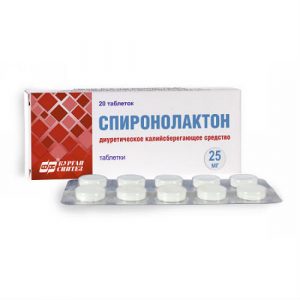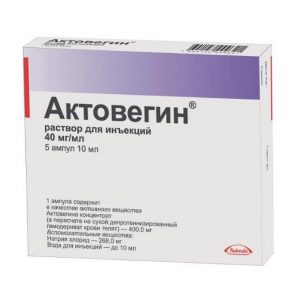Description
Release form
Tablets.
Packing
28 pcs.
Pharmacological action
Lysoretic has an antihypertensive, diuretic effect.
Contraindications
Hypersensitivity to Lysoretic, other ACE inhibitors and sulfanilamide derivatives
anuria
severe renal failure (creatinine Cl <30 ml / min.) angioedema (including the history of ACE inhibitors) hemodialysis using high-temperature membrane porphyria precoma hepatic coma severe diabetes mellitus age 18 years (efficacy and safety not established). Use during pregnancy and lactation Use of lysoretics during pregnancy is contraindicated. When pregnancy is established, the drug should be discontinued as soon as possible. Reception of inhibitors in the II and III trimester of pregnancy has an adverse effect on the fetus (a pronounced decrease in blood pressure, renal failure, hyperkalemia, skull hypoplasia, intrauterine death are possible). There are no data on the negative effects of Lysoretik on the fetus if used during the first trimester. It is recommended to monitor newborns and infants who underwent intrauterine exposure to ACE inhibitors to timely detect a pronounced decrease in blood pressure, oliguria, hyperkalemia. For the period of treatment with the drug, it is necessary to cancel breastfeeding. Special instructions The most pronounced decrease in blood pressure occurs with a decrease in BCC caused by diuretic therapy, a decrease in the amount of salt in food, dialysis, diarrhea or vomiting. In patients with chronic heart failure with simultaneous renal failure or without it, the development of symptomatic hypotension is possible. It is more often detected in patients with severe forms of heart failure, as a result of the use of large doses of diuretics, hyponatremia, or impaired renal function. In such patients, treatment should begin under the strict supervision of a physician. Similar rules should be followed when prescribing to patients with coronary artery disease, cerebrovascular insufficiency, in which a sharp decrease in blood pressure can lead to myocardial infarction or stroke. Influence on the ability to drive vehicles and operate machinery: During the treatment period, patients should refrain from driving vehicles and engaging in potentially dangerous activities, requiring increased concentration of attention and speed of psychomotor reactions, because dizziness is possible, especially at the beginning of the course of treatment. 1 tablet srdl mg, hydrochlorothiazide 12.5 mg. Dosage and administration Take orally 1 tablet. Lysoretica 10 mg + 12.5 mg 1 time / day. If necessary, the dose can be increased to 1 table. Lysoretica 20 mg + 12.5 mg 1 time per day. Doses for renal failure: In patients with CC more than 30 and less than 80 ml / min, the drug can be used only after titration of a dose of individual components of the drug. The recommended initial dose of lisinopril for uncomplicated renal failure is 5-10 mg. Previous diuretic therapy: Symptomatic hypotension may occur after taking the initial dose of the drug. Such cases are more common in patients who had loss of fluid and electrolytes due to previous diuretic treatment. Therefore, it is necessary to stop taking diuretics 2-3 days before the start of treatment with Lysoretic. Side effects The most common side effects are dizziness, headache. Other adverse events From the cardiovascular system: marked decrease in blood pressure, chest pain rarely – orthostatic hypotension, tachycardia, bradycardia, onset of symptoms of heart failure, impaired AV conduction, myocardial infarction. From the digestive tract: nausea, vomiting, abdominal pain, dry mouth, diarrhea, dyspepsia, anorexia, taste change, pancreatitis, hepatitis (hepatocellular and cholestatic), jaundice. From the skin: urticaria, increased sweating, photosensitivity, itching, hair loss. From the side of the nervous system: lability of mood, impaired concentration of attention, paresthesia, increased fatigue, drowsiness, convulsive twitching of the muscles of the limbs and lips rarely – asthenic syndrome, confusion. From the respiratory system: dyspnea, bronchospasm, apnea. From the hemopoietic system: leukopenia, thrombocytopenia, neutropenia, agranulocytosis, anemia (decreased hemoglobin, hematocrit, erythrocytopenia). Allergic reactions: angioedema of the face, limbs, lips, tongue, epiglottis and / or larynx, skin rashes, itching, fever, vasculitis, positive reactions to antinuclear antibodies, increased ESR, eosinophilia. From the genitourinary system: uremia, oliguria / anuria, impaired renal function, acute renal failure From the side of the nervous system: lability of mood, impaired concentration of attention, paresthesia, increased fatigue, drowsiness, convulsive twitching of the muscles of the limbs and lips rarely – asthenic syndrome, confusion. From the respiratory system: dyspnea, bronchospasm, apnea. From the hemopoietic system: leukopenia, thrombocytopenia, neutropenia, agranulocytosis, anemia (decreased hemoglobin, hematocrit, erythrocytopenia). Allergic reactions: angioedema of the face, limbs, lips, tongue, epiglottis and / or larynx, skin rashes, itching, fever, vasculitis, positive reactions to antinuclear antibodies, increased ESR, eosinophilia. From the genitourinary system: uremia, oliguria / anuria, impaired renal function, acute renal failure From the side of the nervous system: lability of mood, impaired concentration of attention, paresthesia, increased fatigue, drowsiness, convulsive twitching of the muscles of the limbs and lips rarely – asthenic syndrome, confusion. From the respiratory system: dyspnea, bronchospasm, apnea. From the hemopoietic system: leukopenia, thrombocytopenia, neutropenia, agranulocytosis, anemia (decreased hemoglobin, hematocrit, erythrocytopenia). Allergic reactions: angioedema of the face, limbs, lips, tongue, epiglottis and / or larynx, skin rashes, itching, fever, vasculitis, positive reactions to antinuclear antibodies, increased ESR, eosinophilia. From the genitourinary system: uremia, oliguria / anuria, impaired renal function, acute renal failure mood lability, impaired concentration, paresthesia, increased fatigue, drowsiness, convulsive twitching of the muscles of the limbs and lips rarely – asthenic syndrome, confusion. From the respiratory system: dyspnea, bronchospasm, apnea. From the hemopoietic system: leukopenia, thrombocytopenia, neutropenia, agranulocytosis, anemia (decreased hemoglobin, hematocrit, erythrocytopenia). Allergic reactions: angioedema of the face, limbs, lips, tongue, epiglottis and / or larynx, skin rashes, itching, fever, vasculitis, positive reactions to antinuclear antibodies, increased ESR, eosinophilia. From the genitourinary system: uremia, oliguria / anuria, impaired renal function, acute renal failure mood lability, impaired concentration, paresthesia, increased fatigue, drowsiness, convulsive twitching of the muscles of the limbs and lips rarely – asthenic syndrome, confusion. From the respiratory system: dyspnea, bronchospasm, apnea. From the hemopoietic system: leukopenia, thrombocytopenia, neutropenia, agranulocytosis, anemia (decreased hemoglobin, hematocrit, erythrocytopenia). Allergic reactions: angioedema of the face, limbs, lips, tongue, epiglottis and / or larynx, skin rashes, itching, fever, vasculitis, positive reactions to antinuclear antibodies, increased ESR, eosinophilia. From the genitourinary system: uremia, oliguria / anuria, impaired renal function, acute renal failure paresthesia, increased fatigue, drowsiness, convulsive twitching of the muscles of the limbs and lips rarely – asthenic syndrome, confusion. From the respiratory system: dyspnea, bronchospasm, apnea. From the hemopoietic system: leukopenia, thrombocytopenia, neutropenia, agranulocytosis, anemia (decreased hemoglobin, hematocrit, erythrocytopenia). Allergic reactions: angioedema of the face, limbs, lips, tongue, epiglottis and / or larynx, skin rashes, itching, fever, vasculitis, positive reactions to antinuclear antibodies, increased ESR, eosinophilia. From the genitourinary system: uremia, oliguria / anuria, impaired renal function, acute renal failure paresthesia, increased fatigue, drowsiness, convulsive twitching of the muscles of the limbs and lips rarely – asthenic syndrome, confusion. From the respiratory system: dyspnea, bronchospasm, apnea. From the hemopoietic system: leukopenia, thrombocytopenia, neutropenia, agranulocytosis, anemia (decreased hemoglobin, hematocrit, erythrocytopenia). Allergic reactions: angioedema of the face, limbs, lips, tongue, epiglottis and / or larynx, skin rashes, itching, fever, vasculitis, positive reactions to antinuclear antibodies, increased ESR, eosinophilia. From the genitourinary system: uremia, oliguria / anuria, impaired renal function, acute renal failure confusion. From the respiratory system: dyspnea, bronchospasm, apnea. From the hemopoietic system: leukopenia, thrombocytopenia, neutropenia, agranulocytosis, anemia (decreased hemoglobin, hematocrit, erythrocytopenia). Allergic reactions: angioedema of the face, limbs, lips, tongue, epiglottis and / or larynx, skin rashes, itching, fever, vasculitis, positive reactions to antinuclear antibodies, increased ESR, eosinophilia. From the genitourinary system: uremia, oliguria / anuria, impaired renal function, acute renal failure confusion. From the respiratory system: dyspnea, bronchospasm, apnea. From the hemopoietic system: leukopenia, thrombocytopenia, neutropenia, agranulocytosis, anemia (decreased hemoglobin, hematocrit, erythrocytopenia). Allergic reactions: angioedema of the face, limbs, lips, tongue, epiglottis and / or larynx, skin rashes, itching, fever, vasculitis, positive reactions to antinuclear antibodies, increased ESR, eosinophilia. From the genitourinary system: uremia, oliguria / anuria, impaired renal function, acute renal failure erythrocytopenia). Allergic reactions: angioedema of the face, limbs, lips, tongue, epiglottis and / or larynx, skin rashes, itching, fever, vasculitis, positive reactions to antinuclear antibodies, increased ESR, eosinophilia. From the genitourinary system: uremia, oliguria / anuria, impaired renal function, acute renal failure erythrocytopenia). Allergic reactions: angioedema of the face, limbs, lips, tongue, epiglottis and / or larynx, skin rashes, itching, fever, vasculitis, positive reactions to antinuclear antibodies, increased ESR, eosinophilia. From the genitourinary system: uremia, oliguria / anuria, impaired renal function, acute renal failurespine, decreased potency. Laboratory indicators: hyperkalemia and / or hypokalemia, hyponatremia, hypomagnesemia, hypochloraemia, hypercalcemia, hyperuricemia, hyperglycemia, increased levels of urea and creatinine in blood plasma, hyperbilirubinemia, hypercholesterolemia, hypertemia, high blood pressure a history of kidney disease, diabetes mellitus and renovascular hypertension. Other: dry cough, arthralgia, arthritis, myalgia, fever, impaired fetal development, exacerbation of gout. Drug Interactions When used simultaneously with potassium-sparing diuretics (spironolactone, triamteren, amiloride), potassium preparations, salt substitutes containing potassium, the risk of hyperkalemia increases, especially in patients with impaired renal function. With simultaneous use with vasodilators, barbiturates, phenothiazines, tricyclic antidepressants, ethanol, the hypotensive effect is enhanced. With the simultaneous use of NSAIDs (indomethacin and others), estrogen decreases the antihypertensive effect of lisinopril. With simultaneous use with lithium preparations, a slowdown in the excretion of lithium from the body is noted (increased cardiotoxic and neurotoxic effects of lithium). With simultaneous use with antacids and colestramine, absorption from the gastrointestinal tract is reduced. The drug enhances the neurotoxicity of salicylates. The drug reduces the effects of oral hypoglycemic agents, norepinephrine, epinephrine and anti-gout agents. The drug enhances the effects (including side effects) of cardiac glycosides, the action of peripheral muscle relaxants. The drug reduces the excretion of quinidine. Reduces the effectiveness of oral contraceptives. Overdose Symptoms: marked decrease in blood pressure. Treatment: artificial vomiting and / or gastric lavage, symptomatic therapy aimed at correcting dehydration and water-salt balance disorders. Isotonic solution should be administered for hypotension. Control of urea, creatinine and electrolytes in serum, as well as diuresis is required. Storage Conditions In a dark place at a temperature not exceeding 15 ° C. Shelf life 2 years. Deystvuyushtee substance Lisinopril, Gidrohlorotiazid Terms and conditions prescription dosage form tablets Possible product names Lizoretik (20mg + 12.5mg) Tab. X28 LYSORETIC 0,02 + 0, 0125 N28 TABLE P / O LYSORETIC TAB 20MG + 12.5 MG No. 28 Lysoretic tab. 20mg + 12.5mg No. 28 Lysoretic tablet 20mg + 12.5mg N28 India
